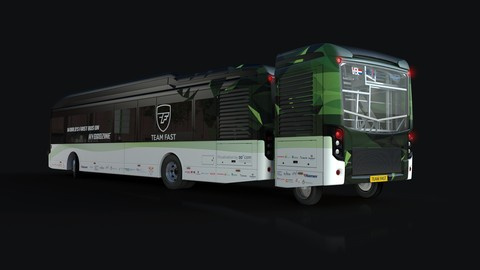Dutch students run the bus on formic acid
 After one and a half years of work, the Team FAST group of 35 students at the Technical University of Eindhoven (Netherlands) is ready to show the result of their work - an electric bus project with an increased power reserve due to the Range-Extender (REX) module on formic (methane) acid. The bus demonstration will take place on July 6, 2017 (you can still register for participation if you are in Eindhoven).
After one and a half years of work, the Team FAST group of 35 students at the Technical University of Eindhoven (Netherlands) is ready to show the result of their work - an electric bus project with an increased power reserve due to the Range-Extender (REX) module on formic (methane) acid. The bus demonstration will take place on July 6, 2017 (you can still register for participation if you are in Eindhoven).
The illustration shows a computer image of a bus with a trailer. This is the first bus in the world capable of working on liquid formic acid. Although formic acid is synthesized today by an artificial method, but theoretically it can be obtained from renewable sources. For example, from nettle, ants and jellyfish. It is enough just to boil the ants in a vessel with water and let the steam through the liquid - you will get a weak solution of formic acid, in this way the English chemist John Rey discovered this substance in the 17th century. Alternatively, you can insist ants on alcohol. That is, it is an environmentally friendly fuel from a renewable source - ants.
The official name of the new energy carrier is Hydrozine. It is 99% composed of formic acid with the addition of an additive to improve efficiency.
Students developed hydrozin for the year from scratch - the first REX model on a reduced scale was shown in early 2016. In fact, this is a completely new type of fuel that was not previously used in the automotive industry. Concentrated formic acid completely provides energy to electric motors, giving a power of 25 kW.
In the oxidation process, formic acid is split into hydrogen and carbon dioxide. It is hydrogen that is used in an engine to produce electricity: when hydrogen is burned, water is produced as a by-product. Carbon dioxide is not emitted into the atmosphere, but is collected for further hydrogenation or homogeneous catalysis - and to obtain the same formic acid. Therefore, the system is generally zero exhaust CO 2 .
The advantage of the new fuel is that it does not require re-equipment of modern hybrid transport that runs on hydrogen. In particular, now a hybrid city electric bus of the Dutch company VDL was equipped with a Range-Extender module on formic acid, and it is already fully operational. In the absence of a REX module, the bus operates as usual with hydrogen from electricity, but with the REX, you can increase the power reserve and save on hydrogen. Theoretically, if the bus ran out of fuel somewhere in remote areas far from gas stations and outlets, the driver could go into the woods and get fuel in the nearest anthill (although he would have to carry out a number of chemical reactions).
Now the development team is completing the tests, and after tomorrow’s presentation there will be a few more months to bring the power reserve module to mind. Students hope that the VDL acid bus will hit the city streets at the end of 2017. True, this summer many members of Team FAST finish their studies, but their place in the team will be taken by junior students.
With the chemical formula HCOOH, formic acid is used in the food industry as a preservative, in medicine as an anesthetic and antiseptic (1.25% formic alcohol), in agriculture for fodder, in the chemical industry as a solvent, in the textile industry for dyeing wool , in perfumery (solvents, fragrances), in leatherworking, and also beekeeping for fight against pincers. Formic acid is registered as a food additive with the E236 index (preservative), but its main use is in agriculture.
Formic acid is found in nettles, fruits, and also in the burning secretions of ants, jellyfish and bees. The effect of contact with formic acid depends on its concentration. A concentration of less than 10% is considered safe, then the solution is irritating and works as an antiseptic. If the concentration is more than 10%, then the corrosive effect is manifested: burns can appear on the skin and it will be painful.
For the first time a substance was found in red ants, hence the name. In the 19th century, they learned to synthesize it artificially. The volume of world production is about 250 thousand tons per year (1980).
At the presentation on July 6, not only the bus will be shown, but also the first gas station with hydrosin. Dutch developers and their automotive industry partners are hoping that in the future, formic acid will become the standard automotive fuel.
Hydrosine is positioned as a cheaper and safer alternative to hydrogen. Although the issue of security is controversial. It should be noted that anhydrous formic acid is called methanoic acid and is considered the strongest carboxylic acid. This is actually an extremely dangerous compound, so when refueling a REX bus you need to remain vigilant so as not to get burned. On the other hand, the tank with formic acid is unlikely to explode like a balloon with hydrogen. Acid does not need to be stored under pressure, which also reduces risks. It is enough to ensure that it does not hit the skin - and this restricts security measures.
All Articles